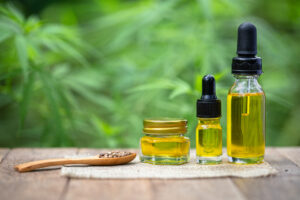Cosmetics & Personal Care
Can the cosmetics industry clear the air around CBD? 12th February 2021
By Kelly Dobos - Cosmetic Chemist MS, MBA

Consumer attitudes toward cannabis are changing and more favorable public perception is motivating many personal care and cosmetic brands to use hemp-derived raw materials, such as cannabidiol (CBD), as functional beauty ingredients with skin benefits. But when it comes to the perception of cannabis ingredients, legitimacy of claims and safety may be key to maintaining the momentum of this positive trend.

The Canna-business of Cosmetics Regulations
In the United States, recent legislative activity has ignited consumer interest in the potential benefits of the cannabis ingredient cannabidiol (CBD) in products ranging from supplements to skin care. The passage of the Agriculture Improvement Act of 2018, also referred to as the ‘Farm Bill’, removed industrial hemp from Schedule I status under the Controlled Substances Act. This allowed for the use of CBD and other derivatives of Cannabis sativa L. in cosmetics as long as tetrahydrocannabinol (THC), the principle psychoactive constituent, content does not exceed 0.3%.
Hemp-derived ingredients
When it comes to hemp-derived ingredients, there are numerous types available with different compositions and claims for use in cosmetics. An oil is simply the crude oil extracted from the seed or plant without any further refinement. Hemp seed oil, while comprised of skin moisturizing fatty acids, is extracted from the seeds of the plant and contains little to no CBD content. CBD oil is made by extracting CBD from the cannabis plant, then diluting it with a carrier oil such as coconut or hemp seed oil. Full spectrum is oil that has not been altered, it contains a rich mixture of cannabinoids, terpenes and flavonoids. In contrast, THC has been removed from oils from those deemed broad spectrum. If the concentration of a specific cannabinoid is >80%, the INCI label name indicates it as such, for example cannabidiol or cannabigerol. Hemp seed oil, while comprised of skin moisturizing fatty acids, is extracted from the seeds
There are about 550 compounds identified in cannabis of which 113 are cannabinoids, and while CBD and THC are the most well-studied cannabidiols, there is further exploration into the ‘entourage effect’ of multiple chemical components of the plant leading to increased efficacy.
Some terpenes, the class of aromatic molecules that give cannabis its distinctive odour, are known allergens. These include limonene and linalool (also found in numbers other plants like citrus and lavender). When used as components of fragrances, they are specifically noted on cosmetic ingredient statements to alert those with known sensitivities so they can avoid exposure. As CBD cosmetics increase in popularity and consumer exposure increases, allergic potential may be a concern that the industry may need to address.
Claims of legitimacy and transparency
As medical research continues to demonstrate the benefits of hemp-derived ingredients, such as CBD, its use as a functional beauty ingredient is also in its infancy. Clinical research and the support of industry are needed to substantiate efficacy and help consumers understand the benefits of hemp-derived ingredients. Purported skin care benefits include skin barrier fortification, and anti-inflammatory and anti-itch properties that could prove useful in treating skin conditions such as dermatitis and psoriasis. Concentrations noted in recent publications with CBD for skincare start as low as 0.1% but many of these studies are in vitro investigations. Much more needs to be done to provide optimized concentrations for specific applications with in vivo testing.
Currently there is a lot of variability in the quality and concentrations of CBD or other functional materials in oils and other hemp-derived ingredients available. A survey of purchased products (mostly supplements and edibles) found that of those that did make a label claim, most did not meet the claimed level of CBD and some contained none at all. It can be surmised that as the demand for these types of products increases, so does the potential to mislead consumers. There is a great need for transparency and traceability in the supply chain, from farm to face.
The drive for standardized testing
The CBD industry is at an early and very important stage in development and understanding the future regulatory situation is critical. Certifications regarding content and quality are likely to emerge from various sources. And, much like the situation with the proliferation of natural certification bodies in cosmetics, there is great potential for conflicting and confounding information.
Groups like the Natural Products Association (NPA) have been pushing for CBD regulation by the FDA and have had several discussions with FDA officials. The National Industrial Hemp Council (NIHC) has filed comments with the FDA regarding its policy of enforcement discretion on CBD cosmetics, requesting clarity regarding standardized testing requirements and laboratory practices, labelling requirements for product transparency, and harmonized definitions for terms like ‘broad spectrum.’
Common cannabis testing includes THC quantification and terpene profiling, but cannabis may be contaminated with heavy metals, fungus, and pesticide residues. Work is underway to develop cost-effective, reliable and repeatable test methods to quantify these potential contaminants. The National Institutes of Standards and Technology (NIST), through its Cannabis Quality Assistance Program (CannaQAP), is working to develop standardized test methods for edibles, tinctures, and balms. By partnering with several cannabis testing labs to analyze data from samples containing specific amounts of THC, CBD and 15 other cannabinoids, the NIST hopes to identify optimum techniques and methodology with the initial results due this month. The NIST is not the only organization working to develop test methods for the cannabis industry: the Association of Official Agricultural Chemists (AOAC) has embarked on a similar endeavour and both organizations are working towards development of methods to quantify trace heavy metals, pesticides, and microbial contaminants including the presence of harmful mycotoxins.
As the interest in hemp-derived ingredients in personal care and cosmetic industry grows, it is clear that there is a need to work closely with regulatory agencies and further scientific research to substantiate efficacy and safety.



